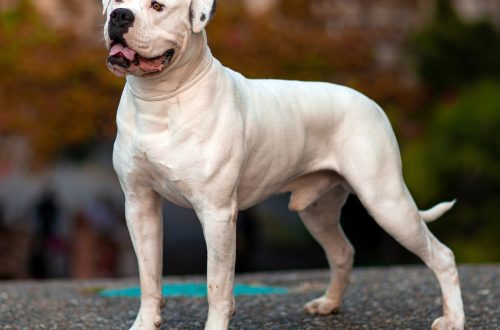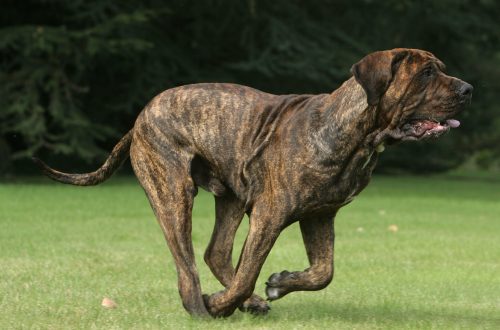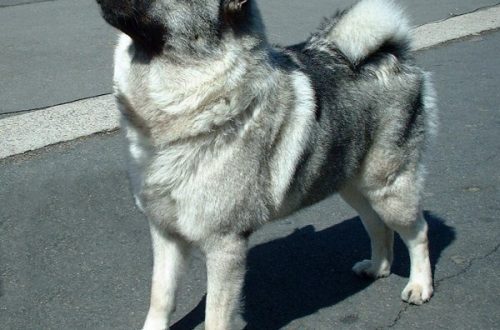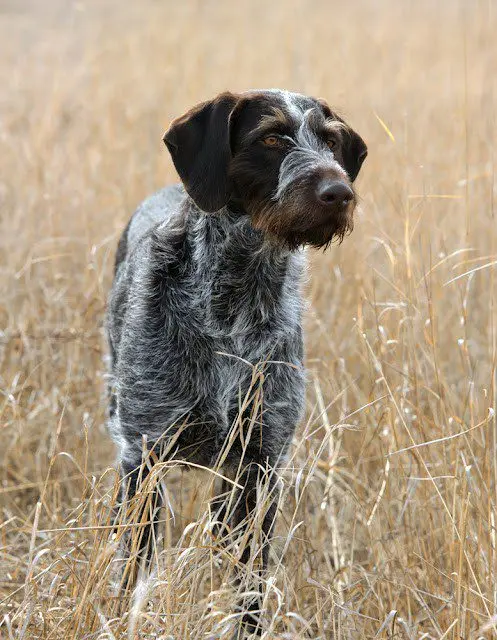
Drathaar (German Wirehaired Pointer)
Other names: German Drathaar , German Wirehaired Pointer
The Drathaar, or German Wirehaired Hound, is a hunter’s best friend and excels in both small and big game.
Contents
Characteristics of Drathaar
| Country of origin | Germany |
| The size | Large |
| Growth | 55-64 cm |
| Weight | 28–45 kg |
| Age | 12–14 years old |
| FCI breed group | 7 – Pointers |
Basic moments
- Drathaar have outstanding memory abilities. They quickly master commands that other hunting dogs take weeks to complete. At the same time, among specialists, the breed is not considered easy to educate.
- German Wirehaired Pointers have sincere sympathy for all family members, but they will truly serve only one of the household members. In addition, they are a little jealous and look askance at any four-legged creature that enjoys the favor of “his majesty the owner.”
- In each drathaar, a tireless hunter of game is sensitively sleeping, so he will never miss a cat or other small animal that he meets on his way. For pets with whom you have to share the same territory, dog aggression, as a rule, does not apply.
- Wire-haired cops are universal hunters, with whom it is equally convenient to go on a hare and a wild boar. In addition, they are excellent at finding and fetching a downed bird, even if it has fallen into a pond.
- Drathaar males are typical dominants with a sharp mind and strong character, so do not expect to grow a cheerful sofa minion out of a male pet.
- These tireless hunters are not at all aggressive towards humans. They certainly do not like strangers, but they will never enter into open conflict with them.
- Drathaars are characterized by increased mobility, bordering on hyperactivity. If you do not plan to take your dog hunting, prepare to spend several hours a day with him outside, supplementing walks with a set of physical exercises.
- The worst thing you can do with a German Wirehaired Hound is to put him in a city apartment, forcing him to spend his days waiting for the return of his late owner.

Drathaars are “whiskered energizers”, deftly managing a wide variety of game species and endlessly adoring their own master. Possessing a sharp mind and a gentle character, they will never show aggression towards a person, no matter what negative emotions he causes in them. At the same time, in all other respects, the drathaars are not so good. Give them the slightest reason to doubt your leadership skills, and those bearded rangers will immediately begin to exploit your loyalty for their own purposes.
History of the Drathaar breed
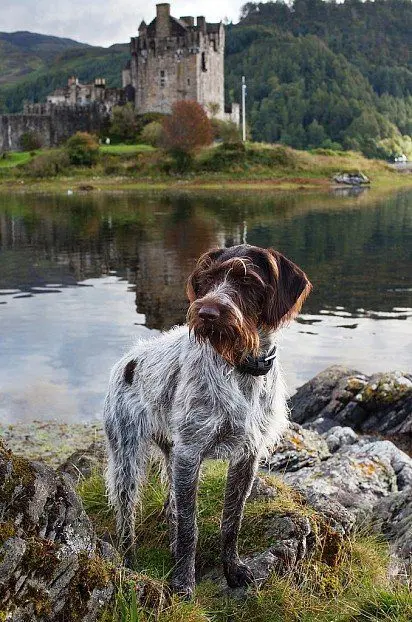
Drathaars are entirely and completely a “product” of the activities of German breeders, which is also hinted at by the name of the breed: “draht” (German) – “wire”, “haar” – “hair”. In the middle of the 19th century, the breeders of the then ununified Germany set out to develop a new kind of pointer, which would incorporate the best working qualities of its predecessors. The future “sample” was supposed to have endurance, excellent flair and the ability to work equally well with both marsh and field game.
In the course of experimental matings, the specialists finally managed to get a generation of hunting dogs with promising potential and a rough, hard coat. The genetic material in this particular case was the well-known to European hunters shtikhelhaars, griffons of Korthals, as well as sharp-witted clever poodles – pointers. According to the breeders, it was the crossing of the representatives of the above breeds that made the Drathaar an ideal hunter, able to work even in adverse weather conditions.
As for public recognition, it came to the German Wirehaired Hounds already in the 70s of the last century. Thirty years later, in 1902, the first drathaar club was founded in Germany, and exactly 22 years later, the International Cynological Federation also entered the animals into its registers. By the beginning of the 20th century, the breed had gained popularity in many countries of Western Europe, including England. But in the New World, drathaars did not immediately find their niche, since American hunters, accustomed to highly specialized dogs, treated the bearded German “emigrants” with a bit of mistrust for a long time.
Drathaar Character
Drathaar is a breed of hunting dog that was bred in Germany at the end of the 19th century. His closest relatives are poodle-pointers, shtichelhaars, German griffons and cops. A distinctive feature of the breed is a hard coat, which allows the dog to work in almost any weather conditions. Hence the name: drahthaar in German means “hard wool”. Hunters all over the world appreciate the breed for its hard work and excellent character. By the way, drathaars appeared in the USSR shortly after the war and quickly gained popularity.
Today, the Drathaar is not only a hunting dog, but also an excellent companion. It is suitable for active people who love walking and sports.
By their nature, drathaars are calm and balanced. But, despite this, they need early socialization and full training . Moreover, it is necessary to train a pet with a professional dog handler . The fact is that in the “teenage” age, the drathaar can be somewhat stubborn and even capricious. Not everyone is able to cope with it, but the dog quickly becomes attached to a person and tries to please the owner in everything.
German Wirehaired Pointer Behaviour
Drathaars are affectionate with all family members, although they choose one leader. With the wrong upbringing, they can be too jealous of the owner. If you notice this possessive feeling in your pet at an early age, try to correct his behavior immediately.
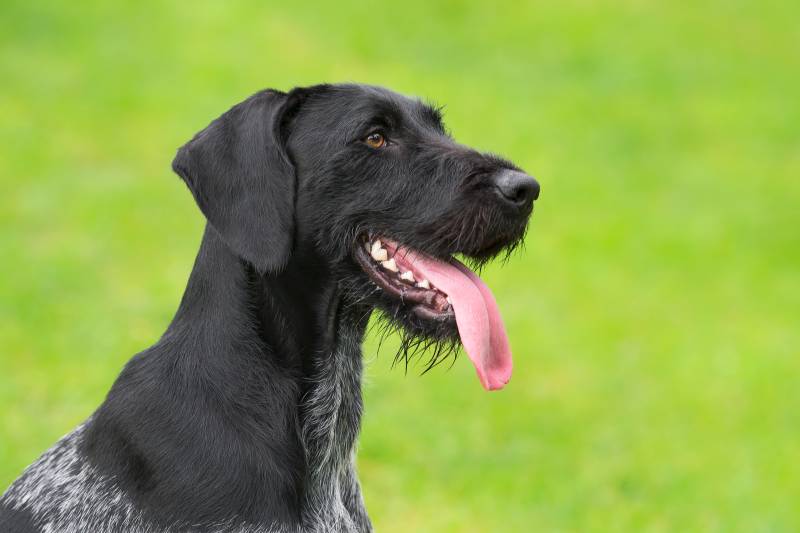


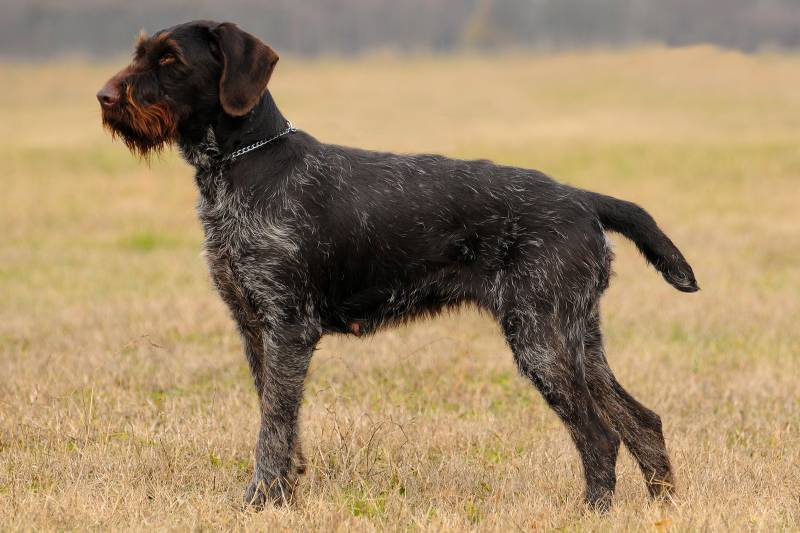
Drathaar is a versatile hunting dog. At the same time, he can also become a wonderful watchman. Representatives of the breed are good-natured and friendly, but only to familiar people, but the pet will not let uninvited guests over the threshold. Despite the peacefulness and the absolute absence of aggression in character, the drathaar will defend its territory to the last.
With other pets in the house, he gets along quite easily, but will try to dominate. If one of the pets does not agree with this hierarchy, conflict is inevitable.
Drathaars are very loyal to school-age children. Joint games and entertainment will bring real pleasure to both the pet and the little owner. But with the kids it is better not to leave the dog alone.
Drathaar Appearance
The appearance of wire-haired cops is original and memorable. The strict, almost military bearing of the dog is complemented by the so-called broad-chested muzzle, which gives the animal an imposing and overly serious look. So, for example, an adult drathaar has a drooping “mustache” and a sparse “beard”, which, combined with an inquisitive look, slightly “age” him.
German wirehaired cops are dogs of medium build, so the weight of an average representative of the breed should not go beyond the 23-32 kg approved by the standard. By the way, due to a somewhat “dried” constitution, drathaars almost do not suffer from obesity, although with a plentiful diet and lack of physical activity they are able to “eat” a few extra kilograms.
Head
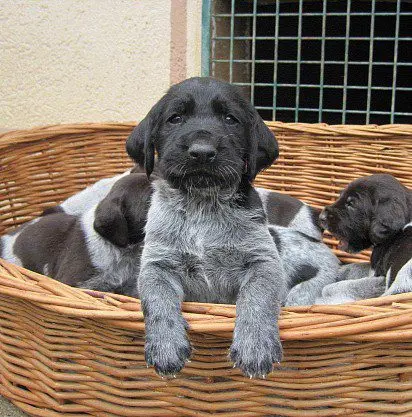
Wide, slightly convex in the lateral parts of the skull with massive superciliary arches and a flat occiput. Muzzle with a slight hump, strong, of sufficient length and width. Stop (transition from forehead to muzzle) is well defined.
Nose
Lobe with wide nostrils, dyed to match the hue of the drathaar coat.
Lips
Fleshy, resilient, tight to the gums. The color of the lips corresponds to the main color of the coat.
Jaws and teeth
Drathaar’s teeth are large, in the amount of 42 pcs. When the jaws close, the lower incisors overlap with the upper ones (scissor bite).
Drathaar Eyes
Not very large, not protruding, not deep set. The eyelids cover the eyeball well. The color of the iris is dark brown. For puppies, a golden hue of the iris is considered acceptable, which becomes darker with age.
Ears
Small. The bases of the ears are set wide apart and set just above the line of the eyes (high set).
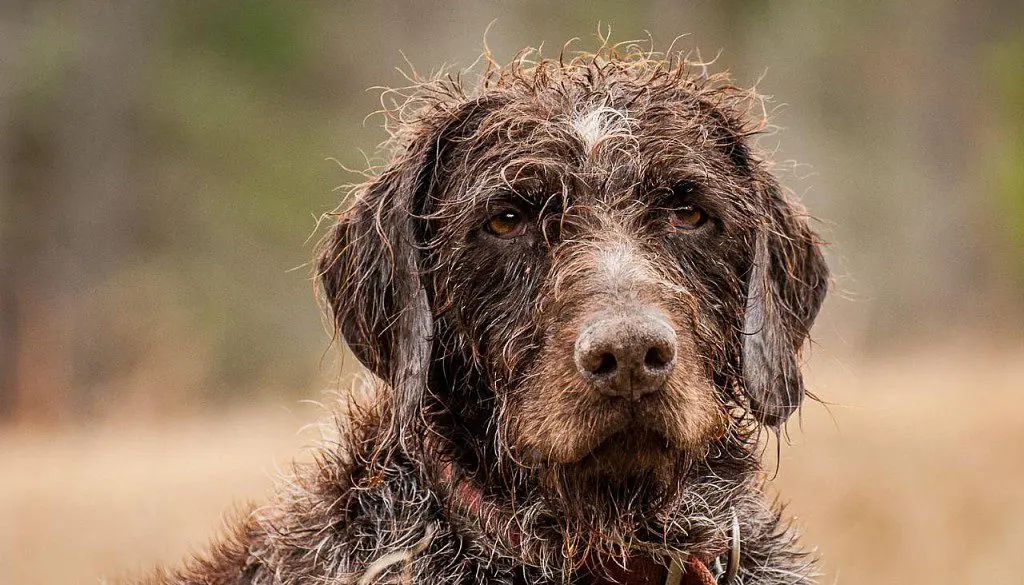
Neck
The neck of the Drathaar is of moderate length, muscular, with a prominent nape and a well-defined throat line.
Frame
Slightly stretched, with a sloping back and a strong, muscular loin. The rump is wide, with a slight slope. The thorax of the Drathaar is deep, noticeably expanding in breadth. The lower part of the body forms a single curved line due to the selected abdomen and tightened inguinal zones.
limbs
The front legs are straight, with oblique shoulder blades and elbows pressed to the body. The wrists are strong, the pasterns are set at an angle. The hind limbs are parallel to each other. The hips of the drathaar are massive, with good musculature. Legs elongated, dry; hocks are strong. All four paws stand in parallel, maintaining their position even when the animal moves. Paw pads are hard, rich color.
Tail
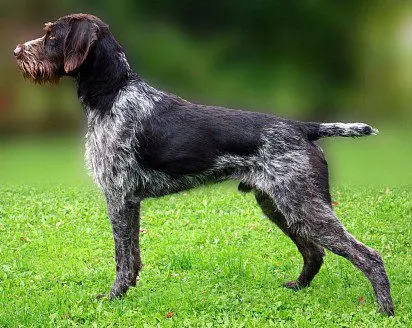
Moderately thick, continuing the line of the croup and carried in a horizontal or slightly raised position. Almost all purebred individuals have a docked tail. Exceptions are drathaars living in countries where this procedure is prohibited by law.
Wool
The coat consists of a “wire” guard hair and an abundant waterproof undercoat, providing the animal with reliable protection from bad weather and accidental injuries. The optimal length of the drathaar coat is 2-4 cm. On the ears, head and belly, the hair is shorter than on the rest of the body.
On the muzzle of the dog, the hair forms expressive “eyebrows” and “beard”.
Color
Drathaars are characterized by densely mottled colors of black and brown tones, which are sometimes complemented by spots. Rarely mottled varieties, as well as completely brown, are also acceptable. Brown individuals are allowed to have a white mark on the chest.
Defects and disqualifying vices
Defects in appearance that prevent show specimens from receiving the highest score include an incomplete dentition, a short and overly pointed muzzle, and sparse hair with a weak undercoat. Drathaaras with drooping eyelids, a humpback or, conversely, a concave back and twisted limbs, the “excellent” rating also does not shine.
There are a number of requirements for the dog’s gait. For example, German Wirehaired Hounds should not amble or mince.
If we talk about disqualification, then animals with such malformations as:
- malocclusion (undershot/overshot);
- distortion of one of the jaws;
- disagreement;
- entropy/ectropy;
- kink or thickening of the tail;
- defective color.
Behavioral deviations are also included in the list of vices, respectively, if they are detected, the question of a pet’s exhibition career will be closed forever. Most often, drathaars are disqualified for cowardice (fear of a shot, game) and increased aggressiveness.
Drathaar’s photo
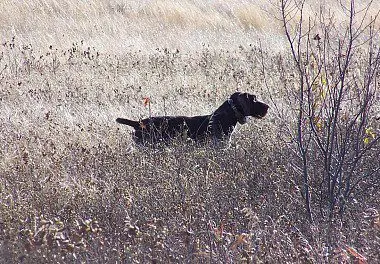
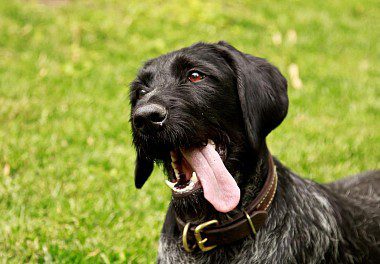
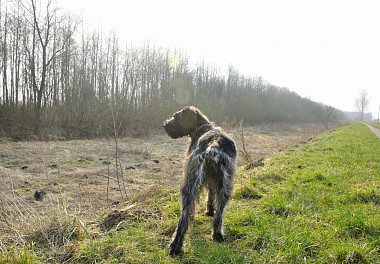

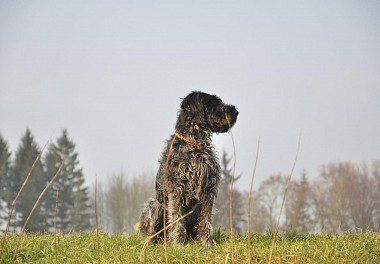
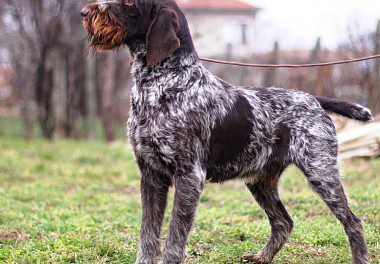
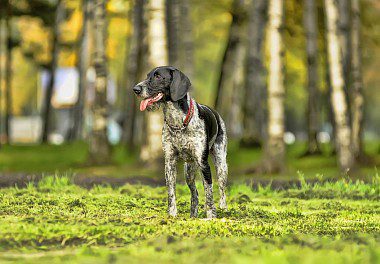
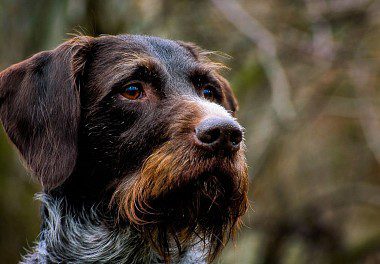
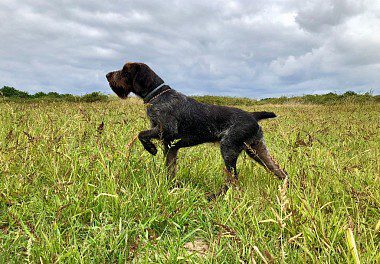
The coarse coat of the Drathaar requires weekly brushing with a furminator . Representatives of the breed shed quite a lot, so in the fall and spring the hair is combed out daily.
Drathaar does not require special grooming. However, some owners still sometimes trim the dog to make it easier to care for it. It is also important to regularly clean the eyes and teeth of the pet.
Maintenance and care
German Wirehaired Pointers are agile and energetic dogs, so keeping them in a city apartment is undesirable. A dream home for a pet will be a cottage or a cottage with a plot, a garden or a forest thicket within walking distance. Drathaars have dense coats and can easily tolerate light frosts, so this breed can be settled in the yard, provided that you provide your pet with a warm double-walled kennel. But do not forget that in case of sharp drops in temperature (-20 ° C), the dog should be taken into the house.
Individuals forced to live in apartments need a good range of walking in combination with sufficient physical activity. Usually drathaars are walked twice a day, and each of these “excursions” should last at least 2-3 hours. You can include elements of training in the walk. For example, it will be useful for a dog to run a couple of kilometers.
Hygiene
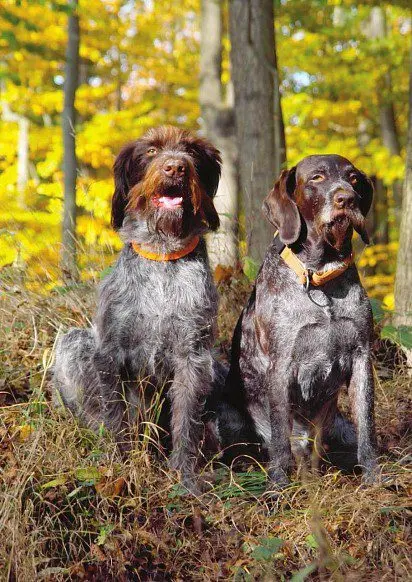
The owner of a drathaar does not have to “dance” around his pet every day with a comb and slicker. The coat of this breed is not the longest and practically does not tangle, so it is enough to brush it once a week to remove dead hairs. But during the molting period, such a procedure will have to be carried out more often, especially if the animal lives in an apartment. To do this, buy a brush with metal teeth, as other varieties with hard “wire” dog hair simply can not cope. It is also useful to comb the drathaar after a run through forests and swamps in order to free the wool from plant seeds and thorns. In addition, for additional protection of the dog’s “fur coat”, you can buy a pair of blankets and put them on your pet every time you go out with him for a walk.
You will have to tinker with the “mustache” and “beard” of the drathaar. While eating, the dog often dips them into a bowl, as a result, particles of food get stuck in the wool, giving the animal an untidy look. Accordingly, after each feeding, the pet’s face must be wiped with a rag, and in especially advanced cases, also washed. If you do not want to turn into a lackey for your four-legged friend, shorten his hair around the muzzle. Of course, the charisma of the drathaar will suffer from this, but you will be spared the need to be on duty near the dog with a napkin.
You can bathe German Wirehaired Hounds up to twice a year, but in fact the animal takes baths much more often, for example, while hunting waterfowl. The ears and eyes of the dog should be checked regularly for inflammation. If the ear funnel of the drathaar is dirty, wipe it with a damp cloth or napkin. It will not be superfluous to lift and straighten the pet’s hanging ear cloth to lightly ventilate the inside of the shell.
Individuals that are often taken for hunting need regular inspection of the paws. In the heat of pursuit, dogs often step on sharp branches, driving particles of wood into the soft surface of the pads. If cracks are found on the paws, this is a signal of a lack of fat in your pet’s diet. In this case, treat the pads with any nourishing cream, additionally including vegetable oil in the dog’s menu.
Once a month, drathaars are treated with antiparasitic agents, which is especially important for animals that are kept in captivity. In the period from March to October, the procedure can be carried out more often, since ticks are activated at this time.
Feeding
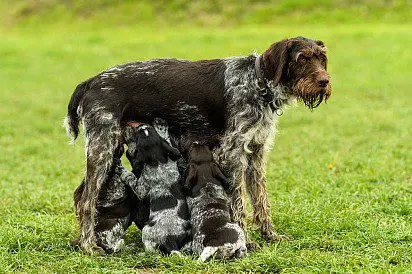
While domestic cynologists continue to advocate natural feeding of wirehaired cops, European breeders successfully treat their pets to “drying”. If you chose the second method, as it is less labor-intensive, please note that the food for the drathaar should be grain-free and contain a large amount of protein (from 30%). Some owners practice mixed feeding, when the animal receives “drying” at one meal, and natural food at the second. This option is not considered ideal, but is allowed by most breeders.
Raw lean meat and offal form the basis of the natural diet of the Drathaar. At the same time, it is absolutely not necessary to feed the dog with tenderloin: German Wirehaired Hounds are willingly content with scraps or meat waste. You can dilute animal proteins in the pet’s diet with buckwheat, rice or oatmeal, as well as fermented milk products. Dog digestion also treats seasonal vegetables quite favorably, if it is not potatoes, peas or beans. Sometimes a drathaar can be pampered with a chicken egg.
Drathaar health and disease
An active lifestyle and natural endurance do not insure German Wirehaired Hounds from a predisposition to a number of diseases. Most often, representatives of this tribe are diagnosed with hip dysplasia, diabetes and hypothyroidism. Aortic stenosis, melanoma and cataracts are also considered fairly common ailments of the breed. In addition, Drathaars often suffer from licked granuloma, eczema and otitis media.
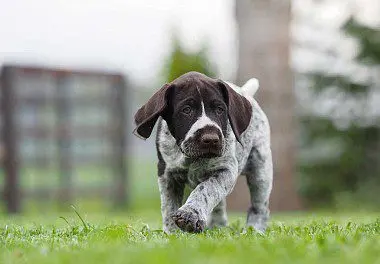
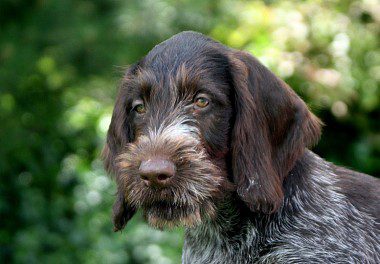
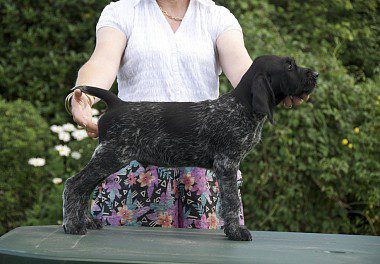
Conditions of detention
Drathaar can be kept in an apartment, subject to regular physical activity, which is necessary for dogs of hunting breeds. But still, the Drathaar will feel best in a country house, where he can run around in the yard in the fresh air.
German Wirehaired Pointer – VIdeo
Education and training
Raising a Drathaar is no more difficult than any other hunting breed. Like most cops, these good-natured “Germans” need a serious mentor who will not abuse the authoritarian style in dealing with them, but will not allow himself to be manipulated. From the first days of the appearance of a Drathaar puppy in the house, they begin to cultivate courage in him. The kid should not be afraid of the sounds of shots and the sight of wild animals, no matter how impressive they may be. It is better to accustom a dog to the smell of gunpowder and gunshots somewhere far away from civilization. Initially, shots are fired at a distance of 200 m from the animal. If the drathaar does not show signs of panic and excitement, the gap is gradually reduced.
Those who are going to grow a professional dead bird fetcher from a pet will have to take a course in swimming in open water with him. To accustom a puppy to bathing should be gradual, as many of them are afraid of water. Never throw a drathaar into a river to develop courage and recklessness in it. Of course, he will not drown, but he will lose trust and respect for you forever.
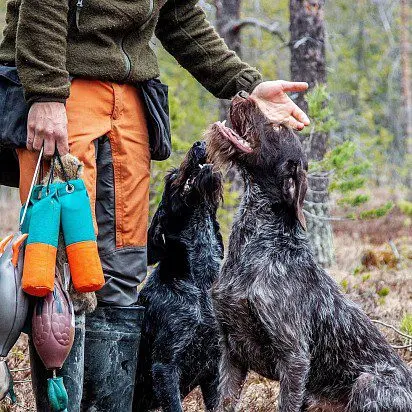
“It is forbidden!” and “To me!” – commands, the meaning of which the representative of the breed of wire-haired cops must learn as early as possible. Only after the puppy learns to quickly and correctly respond to the commanding tone of the owner, you can proceed to get acquainted with fetching. It is desirable to train a dog to carry objects from the age of five months. Traditionally, the training of a Drathaar begins with the fact that a stuffed bird is brought to its nose. The animal must grab the offered “prey” and put it on the floor as soon as it hears the command “Aport!” from the owner.
German Wirehaired Hounds do not like monotony in everything, so it is better to combine several activities during training. Let the pet show itself in all its glory, “loading” it with various tasks for ingenuity and search for objects, not forgetting to intersperse the lessons with jogging and games.
Hunting with a Drathaar
The passion for hunting is inherent in Drathaars at the genetic level, so they are able to catch living creatures even without going through the appropriate training course. For example, dogs living in private homes often give their owners “presents” in the form of rats or field rodents. An additional “amplifier” of the hunting talents of drathaars is their dense, waterproof coat, which protects animals from thorns and sharp branches. In races through the bush, where other cops thoroughly slash their sides, these charismatic “bearded men” only put on thorns and burdock.
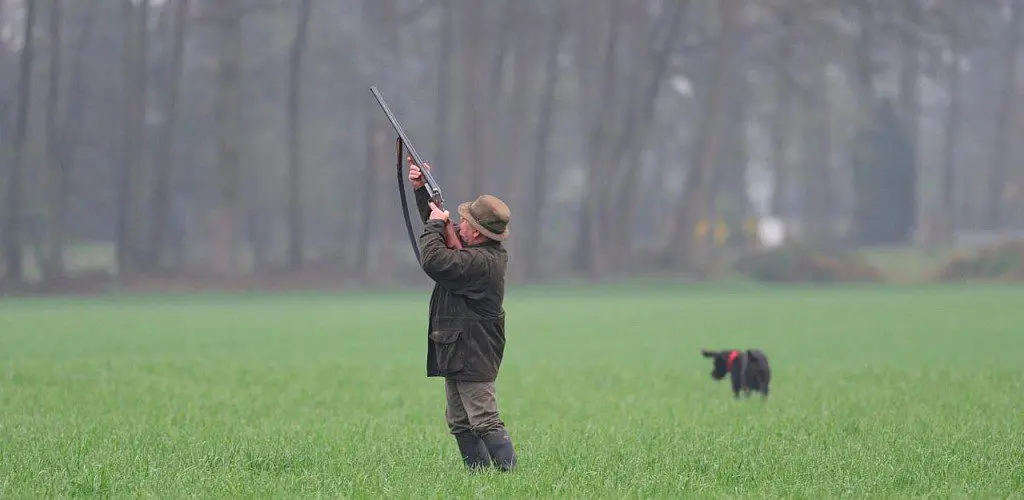
According to domestic hunters, it is better to train a drathaar for any one type of prey. Although in the homeland of the breed, in Germany, wire-haired cops are trained to work simultaneously with three or four varieties of game.
As for the training technique, good results can be achieved by the usual imitation of hunting. As an example: a box is opened in front of a dog sitting next to the owner, from which a bird or one of the forest inhabitants is released. At the same time, the pet must show perseverance, take a stand and wait for the command of the person, and not rush at full speed after the fleeing living creatures.
The specifics of hunting with drathaar for waterfowl depends on the season. If the trip for ducks fell on the cold season, the dog should be fed before it. For the lined prey that has fallen into the icy autumn water, the cop is sent in the very last turn, before heading home. If the dog successfully fished out and brought the game, he is given plenty to run around to keep warm. In summer, when the water is already relatively warm, these rules can be ignored. But allowing a dog to follow a wounded bird through swamps and lakes for more than 15 minutes is definitely not worth it. The wounded animal will still not run far, while such swims will only exhaust the pet.

In addition to hunting waterfowl, you can successfully hunt hares and pheasants with a drathaar. Thanks to their phenomenal instinct and hearing, representatives of this breed are able to smell not only moving, but also lying motionless oblique. As soon as a long-eared object is detected, the dog gives a voice that serves as a kind of guide for the hunter. Wire-haired cops also find pheasants without much effort. Sensing a bird, the dog drives it out of the bush towards the owner so that he can properly aim.
Theoretically, with drathaars you can also go on a wild boar, but, as experience shows, they are not the best poisoners. Lacking sufficient springiness and ease of movement, rough-haired cops often become a target for a wounded angry beast. If you really want to test your pet on big game, train him to hold the prey with his voice without attacking it. Otherwise, your drathaar’s first hunt will be your last.
How to choose a puppy of Drathaar
- Before you start choosing a future pet, visit the breed club or section that controls the breeding activities of kennels to get complete information about matings and true titles of the puppies’ parents.
- If the puppy you like has a weak “mustache” and “beard”, it is better to postpone the purchase for several months. Perhaps, after some time, the hair on the muzzle will grow. If this did not happen, abandon the baby, since such a pet will not pass the “face control” at any exhibition.
- Those who plan to acquire a capable hunter should ask if the puppy’s parents have the appropriate experience. The best option is a baby from a female and a male who have at least two diplomas in swamp and field game.
- Keep an eye on how the Drathaar puppy behaves in the pack. Give preference to curious individuals trying to dominate their brethren.
- Inexperienced owners are better off choosing girls. They are more contact and pliable. Drathaar males are more stubborn and independent, they need a strict and self-confident mentor.
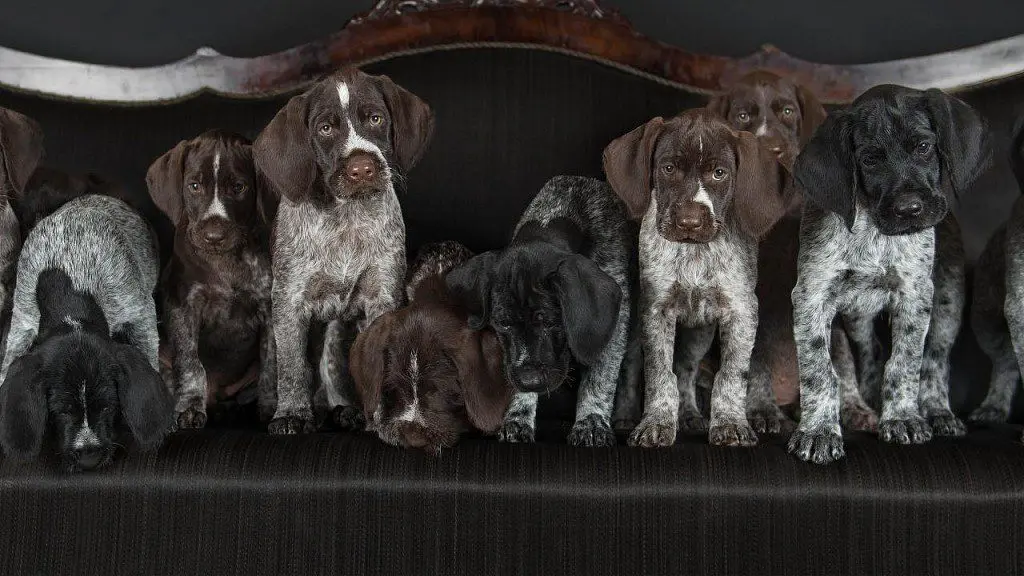
How much is drathaar
You can buy a Drathaar puppy in Russian kennels for 400 – 500$. If the parents of the baby have working (hunting) diplomas, its cost automatically increases: on average, the price tags for such individuals start at 500$. The most economical options are offered by free ad sites. Of course, virtual sellers do not give guarantees about the purity of the breed, but you can buy drathaars from them at very tempting prices: from 200 to 300$.



